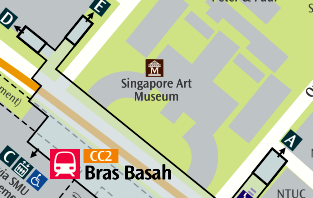The green East West line takes you to Tiong Bahru, quite the hippest hipster hangout with its art deco architecture and frothy coffees. A gem of a find for me is Books Actually, one of those rare independent book stores that gets one all enpassioned, stroking the covers and sniffing the ink.
Read moreInto the Art Garden at Bras Basah
Singapore keeps giving me deja vu. I spend a lot of time standing around thinking, ‘hang on, I’ve been here before’. And then I have to work out whether that was six years ago when I last lived here, or six minutes ago and I’m lost and driving round in circles.
Read moreBugis - jump off for Haji Lane
A lot changes in a little time in Singapore - coming back after a 6/7 year hiatus, it is very much same same but different. For one thing, hipster is now mainstream. Counter culture has arrived in a vintage dress, holding a granny's handbag, dating a skinny bloke in a daft hat. Emerging from Bugis MRT, a shopper has a stark lifestyle choice: enter the mainstream world of Bugis Junction or escape into the indie land of Haji Lane.
Read moreToa Payoh
My home station on the MRT is Toa Payoh. Toe-PIE-oh... only you have to say the ‘toe’ part as fast as is humanly possible, making it more like t’PIE-o. Toa Payoh was the first ever stop on the MRT map - Singapore’s subterranean railway opened in 1987 with a 6km stretch of track from here to Yio Chu Kang.
MRT = Mass Rapid Transport… everything is rapid in Singapore - like the growth of the MRT. There’s also an emphasis on mass, in the sense of ‘for the masses’, which brings me back to Toa Payoh.
Around 85% of Singaporeans live in public housing in the form of tower blocks in model towns, the like of which failed spectacularly in England but (in a classic case of student surpassing master) succeeded in Singapore.
Toa Payoh Town was the first to be entirely purpose-built by the Housing Development Board. And its convenient little high street - actually a few streets lined with all manner of chain- and mom-and-pop shops where I've bought everything from shampoo to a diamond - is thriving. Tell that to Telford.
The HDB arrived in Toa Payoh - the name is Hokkien for ‘big swamp’ - in the 60s, when the area was said to be as rough as Chicago, and most of the residents still lived kampong-style in attap houses. Wooden huts, thatched roofs, stilts to stay out of that ‘big swamp’.
Out on my balcony - 50 years on and 31-storeys up - there are no echoes of the kampong. Traffic is snarling on the PIE, brakes like hundreds of red eyes. I see street lights, flood lights, head lights, neon lights, traffic lights, dreamy submerged swimming pool lights, even the orange light of a gas flare off Malaysia - but no kerosene lamps. If I close my eyes, the cicadas and lapping water could suggest a swamp… but a siren, a TV set, and the little German-sounding bell belonging to a convent school below break the spell.
In the vanguard of the HDB and the MRT, Toa Payoh was a pioneer in the mass, rapid transport of Singapore into the future. “One of Modernisation’s / first ports of calls”, as the poet Koh Buck Song has it.
There are many other reasons to visit Toa Payoh and not just transit at the bus interchange: the remaining dragon playgrounds, the excellent public library with its special kids’ area, the oldest Buddhist temple in Singapore, and a suggestion that the Toa Payoh Long House popiah might just be the best in the country. I’d say “I’ll be back” but I’m already here.
*** I don't have permission to reproduce it, so I won't, but the National Heritage Board has a wonderful photo of the attap houses in Toa Payoh with the new HDB towers in the background taken in 1968.






